Groundhog Day (film)
8.8 /10 1 Votes8.8
96% Rotten Tomatoes 72% Metacritic Genre Comedy, Romance | 8.1/10 IMDb 4/4 Roger Ebert Duration Language English | |||||||||||||||||||||||||||||||||
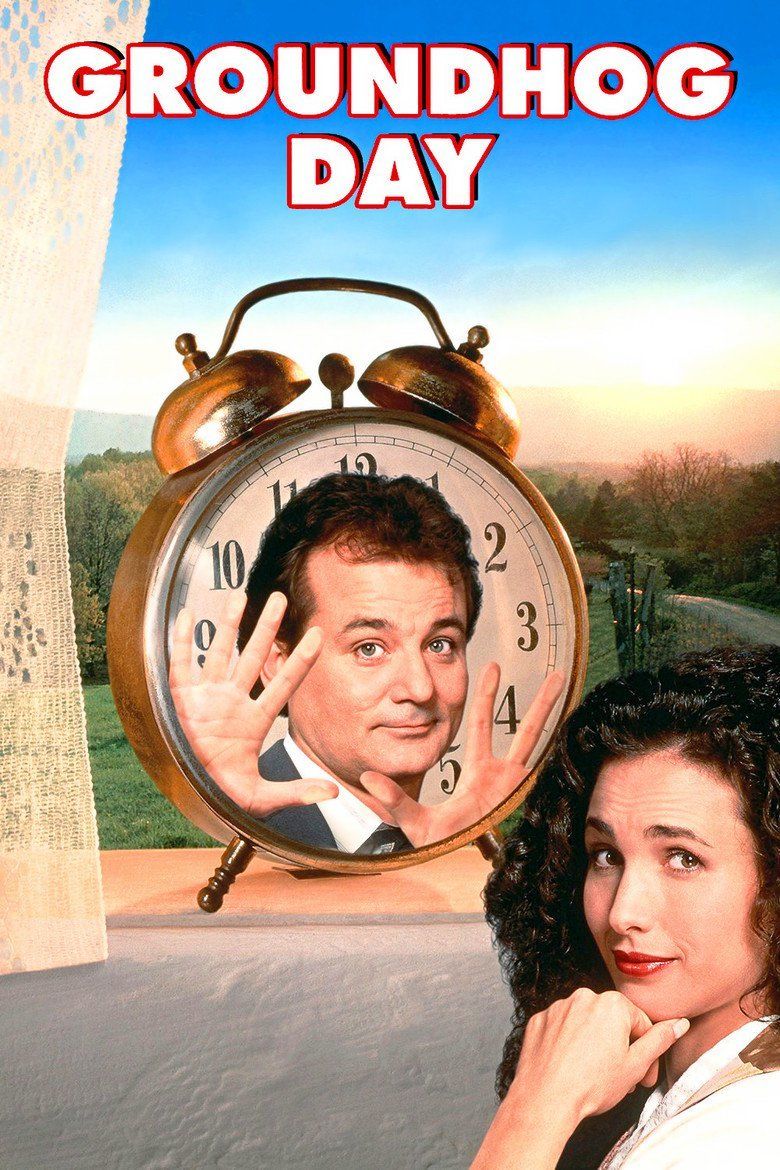 | ||||||||||||||||||||||||||||||||||
Release date February 12, 1993 (1993-02-12) Cast (Phil Connors), (Rita), (Larry), (Ned Ryerson), (Buster Green), (Mrs. Lancaster) Similar movies , Motorama Tagline He's having the worst day of his life... over, and over... | ||||||||||||||||||||||||||||||||||
Groundhog day trailer hd
Groundhog Day is a 1993 American fantasy-comedy film directed by Harold Ramis, starring Bill Murray, Andie MacDowell, and Chris Elliott. It was written by Ramis and Danny Rubin, based on a story by Rubin. Murray plays Phil Connors, an arrogant Pittsburgh TV weatherman who, during an assignment covering the annual Groundhog Day event in Punxsutawney, Pennsylvania, finds himself caught in a time loop, repeating the same day again and again. After indulging in hedonism and committing suicide numerous times, he begins to re-examine his life and priorities.
Contents
- Groundhog day trailer hd
- Ned ryerson groundhog day 1 8 movie clip 1993 hd
- Plot
- Cast
- Concept
- Writing and casting
- Filming
- Critical reception
- Box office
- Accolades
- Interpretations and analysis
- Time loop duration speculations
- Legacy
- Events
- Stage adaptation
- Groundhog day again groundhog day 2 8 movie clip 1993 hd
- References
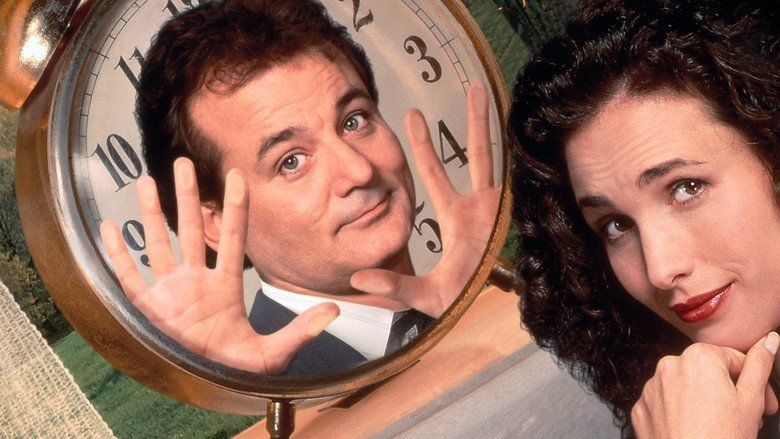
On its release, Groundhog Day was a modest success and garnered generally positive reviews. It gained stronger appreciation among critics and film historians over time, and is now often listed among the best comedy films ever. It further entered into the public consciousness, where the term "Groundhog Day" can represent a situation that seems to repeat over and over in government and military arenas, as well as influencing other entertainment. In 2006, the film was added to the United States National Film Registry as being deemed "culturally, historically, or aesthetically significant". A stage musical version of the story premiered in 2016.
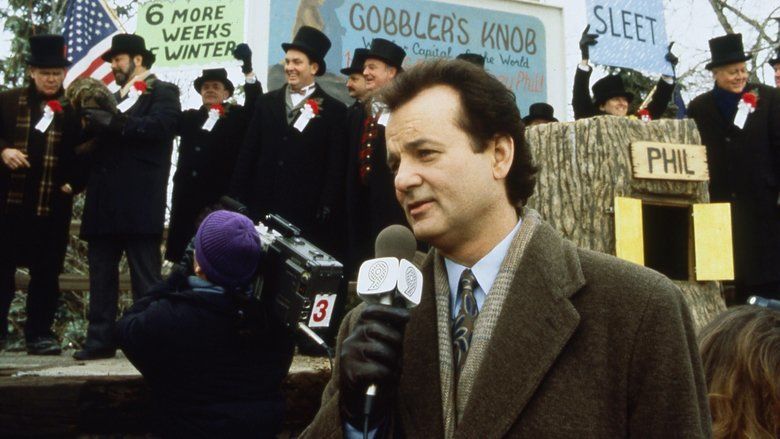
Ned ryerson groundhog day 1 8 movie clip 1993 hd
Plot
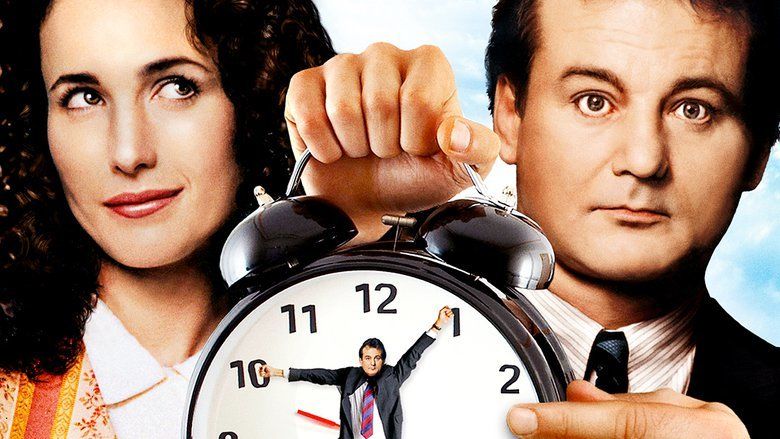
During his nightly TV weather forecast on February 1, weatherman Phil Connors confidently reassures Pittsburgh viewers that an approaching winter storm will miss western Pennsylvania completely. He then sets off with news producer Rita Hanson and cameraman Larry for Punxsutawney, Pennsylvania to cover the next morning's Groundhog Day festivities. Phil makes no secret of his contempt for the assignment, the small town, and the "hicks" who live there.

On February 2, Phil awakens at his Punxsutawney bed and breakfast to Sonny & Cher's "I Got You Babe" on the clock radio and the declaration, "It's Groundhog Day!" He tapes a half-hearted report on Punxsutawney Phil and the town's festivities. Rita wants to stay and cover some of the other events, but Phil wants to return to Pittsburgh immediately. The blizzard—the one that Phil predicted would miss the area—resolves the issue by blanketing the region in snow, stranding them in Punxsutawney. Phil shuns the celebrations and retires to bed early.

Phil wakes to "I Got You Babe" and the same announcement from the radio, and soon discovers the day's events repeating exactly as before. Thinking it is a bad dream, Phil relives the day and returns to bed, only to discover when he wakes, it is still Groundhog Day. He finds he is trapped in a time loop that no one else is seemingly aware of. Phil realizes there are no consequences for his actions, and spends the first several loops in rambunctious behavior, such as binge drinking, one-night stands, and reckless driving. However, Phil soon becomes depressed being stuck in the loop, leading to him to find ways to commit suicide to end the loop, including electrocuting himself with a toaster in a bathtub, and stealing Punxsutawney Phil and driving off a cliff. Even with his apparent deaths, he still wakes up to "I Got You Babe" on February 2.
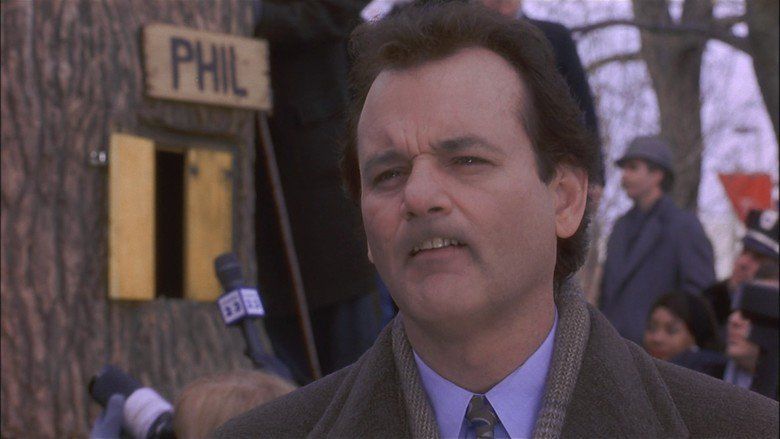
Phil tries to explain his situation to Rita, for whom he has feelings. To demonstrate his plight to Rita, he points out all the trivial actions of the various townsfolk he has memorized due to being stuck in the loop. Rita takes sympathy and they spend the entirety of one loop together, ending up falling asleep on Phil's bed that night. However, Phil still wakes up alone at the start of February 2. He decides to use his knowledge of the day's events to try to better himself and the lives of the townsfolks. Over many loops, he learns how to play the piano, sculpt ice, and speak French. After finding himself unable to prevent the death of a homeless man over several loops, he starts to arrange his actions throughout the day to avert similar accidents and disastrous situations that otherwise would have occurred to the other Punxsutawney residents.
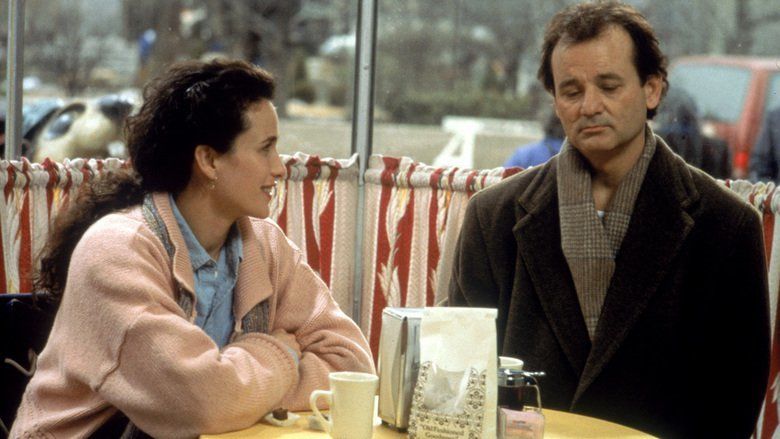
Ultimately, on one loop, Phil eagerly attends the Groundhog Day festivities, and gives a very eloquent report broadcast by all of the other camera crews, amazing Rita. Phil and Rita spend the rest of the day together, with Phil impressing her with his apparent overnight transformation through his contributions to the festivities and helpful nature to the townsfolk. That evening at the town's Groundhog Day dinner-dance, she "wins" Phil with the high bid at the charity bachelor auction. Phil makes a beautiful snow sculpture of Rita's face, and tells her that no matter what happens, even if he is doomed to continue awakening alone each morning forever, he wants her to know that he is finally happy, because he loves her. They retire together to Phil's lodgings.
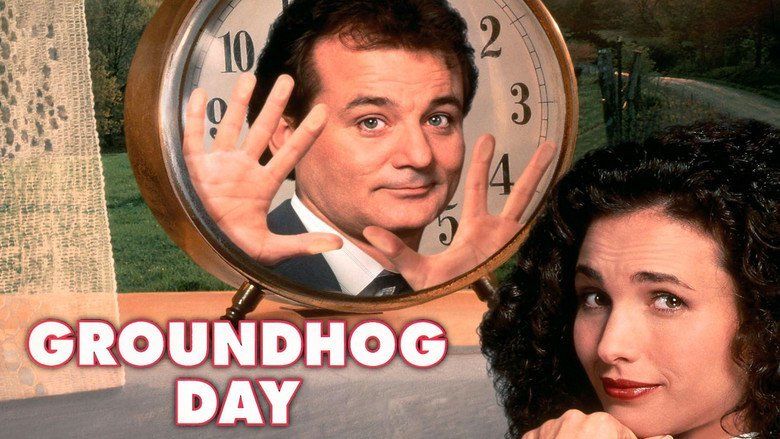
Phil wakes to "I Got You Babe" again, but finds Rita is still in bed with him, and Punxsutawney covered in a fresh blanket of snow; it is February 3 and he has been able to escape the time loop. As they walk out together and marvel at the peaceful, beautiful town, Phil comments to Rita that they should live there—but will rent to start.
Cast
Concept
Danny Rubin had completed and sold his script for Hear No Evil and moved from Chicago to Los Angeles to become a professional scriptwriter around 1990. His agent suggested that he prepare a "calling-card" script that he could use to gain meetings with various producers. He came up with the core idea of the script which would become Groundhog Day while sitting in a movie theater. He had asked himself the question "If a person could live forever, if a person was immortal, how would they change over time?" Having this character be immortal and having the world change around them would have been too cumbersome for filming. Instead he came back to a concept he had written down about two years earlier about a man living the same day over and over. With the idea of a person changing over time, this repeating day motif had found its "deeper purpose" within the new script. The two ideas, combined, answered his proverbial question as well as opened up several possibilities of drama and comedy with that framework.
Rubin first conceived of the dating aspect for the film, "being able to use your superior knowledge to pick up women", which led to the film to lean more into the comedy side. He knew he needed some calendar date to use for the day, and his earlier concept had the character reliving a late January day over and over; when he looked at his calendar, he saw Groundhog Day, February 2, as a date with great potential as a recognized holiday but that had little fanfare, which the film could be played annually similar to Christmas or Halloween specials. Groundhog Day also presented Rubin with the idea of being able to take his character out of his home town into the unfamiliar territory and relative isolation of Punxsutawney, and cementing the character being named Phil in honor of Punxsutawney Phil, as well as making him a weatherman. Rubin took about seven weeks to fix the basic concepts and "rules" for the time loop in the film, and then completed the first draft of the screenplay within three to four days.
Rubin started to shop the screenplay around to around 50 different producers. While many studios expressed interest, they told him they wouldn't be able to film it, though Rubin was able to secure additional work through these meetings. After his own agent left the industry, Rubin hired a spec agent to help sell the script more. The script got to the hands of Richard Lovett in the Creative Artists Agency, who was able to get it to Harold Ramis around 1991, leading to Ramis offering to produce the film.
Writing and casting
In the first draft of the script, Rubin had not wanted to have to explain to the audience how Phil got in the loop, and so had the movie start in medias res, with Phil already in the midst of the looping; the audience would have followed one of his days after waking up to "I Got You Babe" where he is already aware of what will be happening, and thus provoking curiosity to the audience; the film would then have used voice-over narration by Phil to provide some of the backstory. Rita also would confess to being trapped in a time loop of her own. Rubin considered this draft more in line with the black comedy Kind Hearts and Coronets, particularly on how Phil's suicides were presented.
While Ramis wanted to keep this approach, the studio put pressure to use a more standard narrative technique, forcing Rubin to rewrite the script under Ramis' direction. A major change was to restructure the film as a standard three-act piece. This second draft of the screenplay for the film established the reason for Phil to be put in a time loop, according to actor Eddie Deezen. In that version, Phil unceremoniously dumps his current girlfriend Stephanie during the introductory scenes of the film at the studio. While Phil then is at Punxsutawney, a scorned Stephanie figures a way to cast a spell to trap Phil within the loop for 10,000 years. According to Rubin, he felt that he had taken a defensive position in writing these new scenes, feeling that it would "take away everything that was innovative and interesting and turn it into an easily-dismissed Hollywood comedy", and acknowledges that Ramis interceded on his behalf to remove these explanatory scenes while keeping the three-act format.
Another change in the second draft was to change Phil's attitude from having come to accept the nature of the time loop, to one that was more optimistic about being able to end the loop, making the role more amenable and suited for Murray's comedy talents. Ramis had known Murray since their days in The Second City improv troupe and had used him in several successful films prior to Groundhog Day, so he knew how to play on his strengths to convince Murray to take the role. Prior to Murray's casting, Tom Hanks and Michael Keaton turned down the lead role.
Filming
The film was shot in Woodstock, Illinois, 60 miles (97 kilometres) northwest of Chicago near the Wisconsin border, because Punxsutawney "didn’t have a town center that looked good on camera", according to Ramis, and because Punxsutawney's remote location magnified the logistical problems and expense of filming there. Woodstock was a suitable replacement for Pennsylvania in the winter months; further, Ramis knew the area as a Chicago native and recognized it would be easy to obtain licenses to film there and operate the film's production during the winter months. Punxsutawney officials, miffed that their town had been passed over, refused to allow the real Punxsutawney Phil to appear in the movie, but sent representatives to Woodstock to make sure the ceremony was being depicted accurately; according to producer Trevor Albert, the Punxsutawney officers "were actually very pleased" with their recreation of Gobbler's Knob, the site near Punxsutawney used for the Groundhog Day ceremonies. Filming began on March 16, 1992, and continued through May. Much of the filming was done in colder-than-normal weather, with Murray saying that temperatures were often under 20 °F (−7 °C), and had snowfall that lasted through May.
Punxsutawney Phil was played by a series of groundhogs collectively known as Scooter. "[The animals] hated my guts from day one," said Murray, who was bitten twice during shooting, including during the filming of the scene where he drives himself and Phil into a ravine. The bites were severe enough that he was forced to undergo precautionary rabies immunization afterward.
The Tip Top Cafe, where many indoor scenes took place, was a set created for the film; but it became an actual restaurant, the Tip Top Bistro, following the movie's success. Later, it became a coffee and Italian ice cream shop, and after that a fried chicken outlet. The Cherry Street Inn, the Queen Anne-Victorian bed & breakfast where Murray's character stayed, was a private home at the time of filming. Today, it is an actual bed & breakfast.
During the period of filming, Murray was in the midst of marital problems and several crew reported his attitude as erratic. Murray had wanted to make the film less of a comedy as to make it more contemplative, against Ramis' own direction to keep it as a comedy. Rather than to handle Murray's constant phone calls, Ramis had Murray work with Rubin in New York City directly to adjust the script to satisfy Murray's requests. Actor Stephen Tobolowsky described the script changes: "When I got the part, it was still kind of a mediocre Bill Murray movie," he said. "You know, Bill Murray, with no consequences, in comic situations ... It wasn’t until we got into the shooting that everything turned on its head. And it became not only a good movie, not only a great movie, but a classic."
During the time he was working with Rubin, Murray refused to talk to Ramis, according to Rubin. When Murray returned to Woodstock to complete filming, Ramis described his behavior as "just really irrationally mean", and difficult to work with. Following the filming, Ramis and Murray's longtime collaboration and friendship ended abruptly, without public explanation. Except for a few words at a wake, and later at a bar mitzvah, the two men did not speak for almost 20 years after the film's release. Murray finally initiated a reconciliation—at the suggestion of Brian Doyle Murray—only after Ramis entered the final stages of his terminal illness.
Critical reception
The film was released to generally favorable reviews. Janet Maslin of The New York Times called it "a particularly witty and resonant comedy" and Hal Hinson of The Washington Post called it "the best American comedy since 'Tootsie'". Owen Gleiberman of Entertainment Weekly gave it a "B–", and Desson Howe of The Washington Post noted that even though the film is a good Bill Murray vehicle, "'Groundhog' will never be designated a national film treasure by the Library of Congress". Despite this, the film was selected by the National Film Preservation Board for preservation in the Library of Congress in 2006.
Roger Ebert revisited it in his "Great Movies" series. After giving it a three-star rating in his original review, Ebert acknowledged in his "Great Movies" essay that, like many viewers, he had initially underestimated the film's many virtues and only came to truly appreciate it through repeated viewings.
The film is number 32 on Bravo's "100 Funniest Movies". In Total Film's 1990s special issue, Groundhog Day was deemed the best film of 1993 (the year that saw the release of Schindler's List, The Piano, A Perfect World and The Fugitive). In 2000, readers of Total Film voted it the seventh greatest comedy film of all time. The Writers Guild of America ranked the screenplay #27 on their list of 101 Greatest Screenplays ever written. In 2009, American literary theorist Stanley Fish named the film as among the ten best American films ever, writing that "as the movie becomes more serious, it becomes funnier. The comedy and the philosophy (how shall one live?) do not sit side by side, but inhabit each other in a unity that is incredibly satisfying." In 2011, Time Out London named it the 5th-greatest comedy film of all time.
Groundhog Day holds a 96% "Certified Fresh" rating on Rotten Tomatoes. The site's consensus reads "Smart, sweet, and inventive, Groundhog Day highlights Murray's dramatic gifts while still leaving plenty of room for laughs". The film is regarded as a contemporary classic. It has a score of 72 out of 100 at Metacritic.
Box office
The film was a solid performer in its initial release, grossing $70.9 million in North America and ranking 13th among films released in 1993. It was nominated for the Hugo Award for Best Dramatic Presentation, but lost to Jurassic Park.
Accolades
In June 2008, AFI revealed its "Ten Top Ten"—the best ten films in ten "classic" American film genres—after polling over 1,500 people from the creative community. Groundhog Day was acknowledged as the eighth best film in the fantasy genre.
The film is recognized by American Film Institute in these lists:
Interpretations and analysis
The film is often considered an allegory of self-improvement, emphasizing that happiness comes from placing the needs of others above one's own selfish desires. As the released film offers no explanation why the time loop occurs—or why it ends—the viewer is left to draw his or her own conclusions. Rubin has said that while he and Ramis discussed several of the philosophical and spiritual aspects of the film, they "never intended [it] to be anything more than a good, heartfelt, entertaining story".
"Groundhog Day", as an expression, has become shorthand for the concept of spiritual transcendence. As such, the film has become a favorite of some Buddhists who see its themes of selflessness and rebirth as reflections of their own spiritual messages. In the Judeo-Christian tradition, it has been seen as a representation of purgatory. "Connors goes to his own version of hell, but since he’s not evil it turns out to be purgatory, from which he is released by shedding his selfishness and committing to acts of love," wrote Goldberg. "Meanwhile, Hindus and Buddhists see versions of reincarnation here, and Jews find great significance in the fact that Connors is saved only after he performs mitzvahs [sic] (good deeds) and is returned to earth, not heaven, to perform more." It has even been described by some religious leaders as the "most spiritual film of our time". “The curse is lifted when Bill Murray blesses the day he has just lived," wrote the critic Rick Brookhiser. "And his reward is that the day is taken from him. Loving life includes loving the fact that it goes.”
Theologian Michael P. Pholey, writing for Touchstone Magazine, commented on the difficulty of determining a single religious or philosophical interpretation of the film, given Ramis's "ambiguous religious beliefs" as "an agnostic raised Jewish and married to a Buddhist", and suggested that when not viewed through a "single hermeneutical lens", the film could be seen as "a stunning allegory of moral, intellectual, and even religious excellence in the face of postmodern decay, a sort of Christian-Aristotelian Pilgrim’s Progress for those lost in the contemporary cosmos." Others see an interpretation of Nietzsche’s directive to imagine life—metaphorically or literally—as an endless repetition of events. "How would this shape your actions?" asks Goldberg. "What would you choose to live out for all eternity?"
Time loop duration speculations
In relationship to the spiritual interpretations of the films, many have tried to estimate how long Phil supposedly remains trapped in the loop, in real time, with a wide variance in estimated values. During filming, Ramis, who was a Buddhist, observed that according to Buddhist doctrine, it takes 10,000 years for a soul to evolve to its next level. Therefore, he said, in a spiritual sense, the entire arc of Groundhog Day spans 10,000 years. Deezen noted that the second draft of the screenplay called for Phil to be cursed to live the time loop for 10,000 years. In the DVD commentary, Ramis estimated a real-time duration of 10 years. Later, Ramis told a reporter, "I think the 10-year estimate is too short. It takes at least 10 years to get good at anything, and allotting for the down time and misguided years he spent, it had to be more like 30 or 40 years."
In 2005, Rubin said, "Ultimately it became this weird political issue because if you asked the studio, 'How long was the repetition?', they'd say, 'Two weeks'. But the point of the movie to me was that you had to feel you were enduring something that was going on for a long time ... For me it had to be—I don't know. A hundred years. A lifetime." In 2014, the website WhatCulture combined various time duration assumptions and estimated that Phil spent a total of 12,395 days—just under 34 years—reliving Groundhog Day.
Legacy
The narrative of a protagonist trapped in a time loop, where escape is only possible after accumulating knowledge through multiple passes, is a popular trope in fictional works. Rubin noted that with his script, he "stumbled upon a story with all the makings of a classic, so simple and true that it could be retold many different ways by many different storytellers." Though not the earliest example, the trope has been named after Groundhog Day by the website TVTropes and other sources because the film established the trope in popular culture. Such films as Edge of Tomorrow and ARQ have used it, as have television shows; one of the more recognized examples is The X-Files episode "Monday". Other genres, including sit-coms and dramas, have employed it as well. Pilot Viruet, in the magazine Vice, wrote, "Because of the inherent reset button the trope provides, an episode of TV can explore different scenarios, plots, character interactions, and outcomes—and if any of them don't quite feel right, the writers can start over (often with the ringing of a shrill alarm clock)."
The phrase "Groundhog Day" has entered common usage as a reference to an unpleasant situation that continually repeats. Goldberg paraphrased the common meaning as "same stuff, different day". In the military, referring to unpleasant, unchanging, repetitive situations as "Groundhog Day" became widespread soon after the movie's release in February 1993. A magazine article about the aircraft carrier USS America mentions its use by sailors in September 1993. The film was a favorite among the Rangers deployed for Operation Gothic Serpent in Somalia in 1993, because they saw the film as a metaphor of their own situation, waiting monotonous long days between raids. In February 1994, crew members of the aircraft carrier USS Saratoga referred to their deployment in the Adriatic Sea, in support of Bosnia operations, as Groundhog Station. A speech by President Clinton in January 1996 specifically referred to the movie and the use of the phrase by military personnel in Bosnia. Fourteen years after the movie's release, "Groundhog Day" was noted as common American military slang for any day of a tour of duty in Iraq, often as a successor to the World War II-era slang term "SNAFU" ("Situation Normal: All Fucked Up").
In his Iraq War memoir Victory Denied, MAJ Roger Aeschliman describes guarding assorted visiting dignitaries as his "Groundhog Day":
The dignitary changes but everything else is exactly the same. The same airplanes drop them off at the same places. The same helicopters take us to the same meetings with the same presenters covering the same topics using the same slides. We visit the same troops at the same mess halls and send them away from the same airport pads to find our own way home late at night. Over and over and over and over and over and over and over and over and over until we are redeemed and allowed to go home to Kansas. Amen.
In the 2015 memoir, Guantánamo Diary, Mohamedou Ould Slahi refers to the film twice to describe his ongoing confinement in Guantanamo, Cuba.
Member of Parliament Dennis Skinner compared British Prime Minister Tony Blair's treatment following the 2004 Hutton Inquiry to the film. "[The affair] was, he said, like Groundhog Day, with the prime minister's critics demanding one inquiry, then another inquiry, then another inquiry." Blair responded, "I could not have put it better myself. Indeed I did not put it better myself."
Events
The town of Punxsutawney has seen much larger crowds at the annual Groundhog Day event since the film's release.
Since 1992, Woodstock has staged an annual Groundhog Day festival, featuring a dinner dance, free screenings of the movie, and a walking tour of the opera house, bowling alley, movie theatre, Moose Lodge (site of the dinner dance scene), piano teacher's house, Cherry Street Inn, and other locations from the film.
On February 2, 2016, fans of the film in Liverpool experienced their own "Groundhog Day" by binge-watching the film 12 times in 24 hours.
Stage adaptation
Although Stephen Sondheim expressed interest in creating a musical adaption of the film in 2003, he eventually concluded that " ... to make a musical of Groundhog Day would be to gild the lily. It cannot be improved." Nevertheless, Ramis announced in 2009 that Rubin was working on an adaptation. At a 2014 concert in Hyde Park, the Australian comedian and lyricist Tim Minchin performed a song he had written for the show, "Seeing You".
The musical was officially confirmed in April 2015, with a book by Rubin based on his and Ramis's original screenplay, directed by Matthew Warchus, choreography by Peter Darling, design by Rob Howell, and an original score and lyrics by Minchin. The production reunites most of the creative team behind the 2010 musical Matilda. It premiered in 2016 at The Old Vic theatre in London as part of Warchus's debut season as artistic director there. Broadway performances began in March 2017.
Groundhog day again groundhog day 2 8 movie clip 1993 hd
References
Groundhog Day (film) WikipediaGroundhog Day (film) IMDbGroundhog Day (film) Rotten TomatoesGroundhog Day (film) Roger EbertGroundhog Day (film) MetacriticGroundhog Day (film) themoviedb.org
